What are the typical pressure and temperature ratings for black iron tee fittings?
Black iron tee fittings, also known as malleable iron tee fittings, have typical pressure and temperature ratings that depend on their size and the standards they adhere to.
Here are some general guidelines:
- Pressure Ratings: Black iron tee fittings are typically rated for different pressure classes, which indicate their maximum working pressure. Common pressure classes for black iron tee fittings include Class 150 and Class 300. Class 150 fittings are suitable for low to moderate pressure applications, while Class 300 fittings are designed for higher pressure systems. The specific pressure ratings can vary based on the size and standard followed.
- Temperature Ratings: The temperature ratings of black iron tee fittings are influenced by the material’s ability to withstand thermal expansion and contraction. Malleable iron fittings are generally suitable for temperatures ranging from -20°C (-4°F) to 230°C (446°F). However, it is important to note that the temperature limits can vary depending on factors such as the application, the fluid or gas being transported, and the specific standard or code being followed.
It’s crucial to consult the manufacturer’s specifications or the relevant industry standards to determine the precise pressure and temperature ratings for a particular size and type of black iron tee fitting. Additionally, local codes and regulations may have specific requirements that need to be considered when selecting and using black iron tee fittings in plumbing or industrial systems.
How is a black iron tee fitting installed or connected in a pipe system?
A black iron tee fitting is typically installed or connected in a pipe system using threaded connections.
Here is a general overview of the installation process:
- Prepare the Pipes: Ensure that the ends of the pipes and the threaded portion of the tee fitting are clean and free from debris or dirt. You may need to use a pipe brush or emery cloth to clean the surfaces.
- Apply Thread Sealant: Apply an appropriate thread sealant, such as pipe thread sealant tape or pipe joint compound, to the male threads of the pipe and the female threads of the tee fitting. The sealant helps create a tight and leak-free connection.
- Assemble the Fitting: Insert the threaded end of the pipe into the corresponding female threads of the tee fitting. Rotate the fitting clockwise to tighten it onto the pipe. Use a pipe wrench or adjustable wrench to securely tighten the connection. Ensure that the fitting is aligned properly to achieve the desired orientation.
- Repeat for Other Connections: If additional pipes need to be connected to the tee fitting, repeat the process for each connection. black iron tee fitting Apply thread sealant to the male threads of each pipe and the female threads of the tee fitting, and tighten the connections using appropriate wrenches.
- Test for Leaks: Once all the connections are made, it is important to test the system for leaks. You can do this by pressurizing the system, either with air or water, and inspecting all the joints and connections for any signs of leakage. If any leaks are detected, disassemble the connection, reapply thread sealant, and reassemble the fitting.
Note that the specific installation process may vary depending on the size, application, and industry standards. It is important to follow the manufacturer’s instructions and any applicable local codes or regulations when installing black iron tee fittings or any other pipe fittings. Additionally, it is recommended to consult with a professional plumber or pipefitter if you are unsure about the proper installation technique.


Comments are closed.